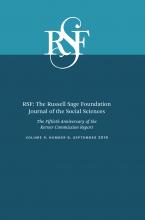Abstract
This article studies the evolution of African American neighborhoods since the publication of the groundbreaking Kerner Commission report in 1968. We first examine how black and riot-affected neighborhoods evolved in four representative cities—Detroit, Newark, Los Angeles, and Washington, D.C.—during this period. Among black neighborhoods in these cities, we find that black neighborhoods not directly affected by riots fare better but trend similar to those that were. Notably, a number of disparities the commission identified as policy priorities—such as relatively lower income, higher poverty, and higher unemployment—persist despite declines in racist attitudes, extreme segregation, and an increased suburbanization of blacks. Fifty years after its publication, these findings suggest that the concerns of the Kerner Commission report remain relevant.
- © 2018 Russell Sage Foundation. Casey, Marcus D., and Bradley L. Hardy. 2018. “The Evolution of Black Neighborhoods Since Kerner.” RSF: The Russell Sage Foundation Journal of the Social Sciences 4(6): 185–205. DOI: 10.7758/RSF.2018.4.6.09. We thank the editors and three anonymous reviewers for helpful comments that improved the paper. We also thank William Collins for allowing us access to a subset of the Collins and Margo tract-level data on riot locations for use in this study. Finally, we would like to acknowledge the seminar participants at the Russell Sage Foundation and the Institute on Research on Race and Public Policy, University of Illinois at Chicago. Direct correspondence to: Marcus D. Casey at mcasey{at}brookings.edu, 1775 Massachusetts Ave. N.W., Washington, D.C. 20036; and Bradley L. Hardy at hardy{at}american.edu, 4400 Massachusetts Ave. N.W., Washington, D.C. 20016.
Open Access Policy: RSF: The Russell Sage Foundation Journal of the Social Sciences is an open access journal. This article is published under a Creative Commons Attribution-NonCommercial-NoDerivs 3.0 Unported License.






